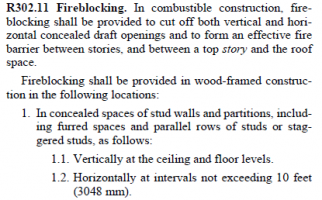-
Welcome to the new and improved Building Code Forum. We appreciate you being here and hope that you are getting the information that you need concerning all codes of the building trades. This is a free forum to the public due to the generosity of the Sawhorses, Corporate Supporters and Supporters who have upgraded their accounts. If you would like to have improved access to the forum please upgrade to Sawhorse by first logging in then clicking here: Upgrades
You are using an out of date browser. It may not display this or other websites correctly.
You should upgrade or use an alternative browser.
You should upgrade or use an alternative browser.
Fireblocking
- Thread starter jmc
- Start date
ICE
Oh Well
Typical residential gets a foam that is listed as a fire-block. Hilti makes a fire-block caulk that is intumescent. Fiberglass insulation can qualify if done correctly.
Non-residential is supposed to be specified by the architect or designer and then approved by a plan checker for the jurisdiction. There are variables as to cycles of expansion and contraction, the size of the gap being filled, what the surrounding material is and more. Hilti makes a ring that swells in fire to take up the space created by melting pipe or conduit.
Non-residential is supposed to be specified by the architect or designer and then approved by a plan checker for the jurisdiction. There are variables as to cycles of expansion and contraction, the size of the gap being filled, what the surrounding material is and more. Hilti makes a ring that swells in fire to take up the space created by melting pipe or conduit.
JBI
Registered User
I agree with ICE, intumescent caulks are generally listed for that application.
steveray
SAWHORSE
3M makes an "FB136" I believe....Any "rated" caulk I would accept or specifically tested for IRC fireblocking...Or, in theory these days, if the wall is insulated, you don't need it....
Shhhhh....don't tell the contractors....
R302.11.1.2 Unfaced fiberglass. Unfaced fiberglass
batt insulation used as fireblocking shall fill the entire
cross section of the wall cavity to a minimum height of
16 inches (406 mm) measured vertically. When piping,
conduit or similar obstructions are encountered, the insulation
shall be packed tightly around the obstruction.
Shhhhh....don't tell the contractors....
R302.11.1.2 Unfaced fiberglass. Unfaced fiberglass
batt insulation used as fireblocking shall fill the entire
cross section of the wall cavity to a minimum height of
16 inches (406 mm) measured vertically. When piping,
conduit or similar obstructions are encountered, the insulation
shall be packed tightly around the obstruction.
tmurray
SAWHORSE
IRC/2006: R302.11(4)
What would be an approved material for sealing penetrations around wiring, pipes, vents, etc?
The labeling on most cans of the orange spray foam I see indicate that it's not approved for fireblocking.
It depends on the fire rating desired, the annular space (space between the building structure and the service that's penetrating it), the construction materials used for the assembly, the material of the penetrating product, and the size of the penetrating product. Could be anything from a fire rated caulking to a sleeve/collar. Hilti STI and 3M all would provide this type of product.
mtlogcabin
SAWHORSE
The Great Stuff foam is approved for fire blocking in non-rated assemblies
http://www.icc-es.org/Reports/pdf_files/load_file.cfm?file_type=pdf&file_name=ESR-1961.pdf
http://www.icc-es.org/Reports/pdf_files/load_file.cfm?file_type=pdf&file_name=ESR-1961.pdf
IJHumberson
SAWHORSE
IRC/2006: R302.11(4)
What would be an approved material for sealing penetrations around wiring, pipes, vents, etc?
The labeling on most cans of the orange spray foam I see indicate that it's not approved for fireblocking.
Per R302.11 fireblocking at openings at vents, pipes, ducts, cables, etc., must be of an approved material. This should not be confused with a listed product. "Approved", as defined in Chapter 2, means that it is acceptable to the building code official. Therefore, most products are not going to indicate whether or not they are 'approved' - usually they will indicate if they are listed. I think most building code officials accept the orange expanding foam insulation when used in walls that are not required to have a fire resistance rating.
ICE
Oh Well
Almost nobody seals top and bottom wall plates.
mtlogcabin
SAWHORSE
Energy code requires sealing top platesAlmost nobody seals top and bottom wall plates.
R302.11 Fireblocking.Almost nobody seals top and bottom wall plates.
In combustible construction, fireblocking shall be provided to cut off both vertical and horizontal concealed draft
openings and to form an effective fire barrier between stories, and between a top story and the roof space. ...
IRC 2009, 2012, 2015I think most building code officials accept the orange expanding foam insulation when used in walls that are not required to have a fire resistance rating.
R302.11 Fireblocking (4).
4. At openings around vents, pipes, ducts, cables and wires at ceiling and floor level, with an approved material to
resist the free passage of flame and products of combustion. The material filling this annular space shall not be required to meet the ASTM E 136 requirements.
A laundry list of fireblocking materials can be found in R302.11.1
ICE
Oh Well
Wall top and bottom plates are fireblocks. The integrity of fireblocks shall be maintained.

